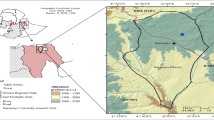Abstract
Rice fields are either continuously flooded or drained in China in the winter (non-rice growth season). Due to great spatial variation of precipitation and temperature, there is a spatial variation of soil moisture in the fields under drained conditions during the winter season. The effect of water regime in winter on CH4 emissions during the following rice growing period and their regional variation were investigated. Soil moisture in the winter was simulated by DNDC model with daily precipitation and temperature as model inputs. Under the same management during the rice growing period, CH4 emissions was higher from rice fields flooded, compared to those from fields drained during winter. CH4 emission from rice fields correlated significantly with simulated soil moisture and with mean precipitation of the preceding winter season. Spatial variation of precipitation in winter and corresponding variations of soil moisture regimes control the regional and annual variation of CH4 emissions from rice fields in China. Keeping soils drained as much as possible during winter seems to be a feasible option to reduce CH4 emissions during the following rice growing seasons.
Similar content being viewed by others
References
Blake DR & Rowland FS (1988) Continuing worldwide increase in tropospheric methane, 1978 to 1987. Science 239: 1129–1131
Cai ZC (1997) A category for estimate of CH4 emission from rice paddy fields in China. Nutr Cycl Agroecosyst 49: 171–179
Cai ZC, Tsuruta H & Minami K (2000) Methane emission from rice fields in China: measurements and influencing factors. J Geophys Res 105: 17231–17242
Cai ZC, Xing GX, Shen GY, Xu H, Yan XY, Tsuruta H, Yagi K & Minami K (1999) Measurements of CH4 and N2O emissions from rice paddies in Fengqiu, China. Soil Sci Plant Nutr 45: 1–13
evevre OC & Horwath WR (2000) Decomposition of rice straw and microbial carbon use efficiency under different soil temperature and moisture. Soil Biol Biochem 32: 1773–1785
Ding A, Willis CR, Sass RL, Fisher FM (1999) Methane emissions from rice fields: effect of plant height among several rice cultivars. Global Biogeochem. Cycles 13(4): 1045–1052
Dlugokencky EJ, Masaire KA, Lang PM & Tans PP (1998) Continuing decline in the growth rate of the atmospheric methane burden. Nature 393: 447–450
Editorial Board of Agricultural Yearbook of China (1993–1998) Agricultural Yearbook of China, Agricultural Press, Beijing
Etheridge DM, Pearman GI & Fraser PJ (1992) Changes in tropospheric methane between 1841 and 1978 from a high accumulation rate Antarctic ice core. Tellus 44: 282–294
Fetzer S, Bak F & Conrad R (1993) Sensitivity of methanogenic bacteria from paddy soil to oxygen and desiccation. FEMS Microbiol Ecol 12: 107–115
IRRI-International Rice Research Institute (1991) World Rice Statistics 1990
Joulian C et al. (1996) Microbiological aspects of methane emission by a rice field soil from the Camargue (France). 1. Methanogensis and related microflora. European J Soil Sci 32: 61–70
Kern JS, Gong ZT, Zhang GL, Zhu HZ & Luo GB (1997) Spatial analysis of methane emissions from paddy soils in China and the potential for emissions reduction. Nutr Cycl Agroecosyst 49: 181–195
Khalil MAK, Rasmussen RA, Wamg MX & Ren R (1991) Methane emission from rice fields in China. Environ Sci Techn 25: 970–981
Li CS (2000) Modeling trace gas emissions from agricultural ecosystems. Nutr Cycl Agroecosyst 58: 259–276
Pavlostathis SG & Giraldo-Gomez E (1991) Kinetics of anaerobic treatment. Water Sci Technol 24: 35–39
Sass RL (1994) Mitigation of methane emissions from irrigated rice agriculture. The Earth Obs 5: 64–65
Shannon RD & White JR (1994) A three year study of controls on methane emissions from two Michigan Peatland, Biogeochemistry 27: 35–60
Singh S, Singh JS & Kashyap AK (1999) Methane flux from irrigated rice fields in relation to crop growth and N-fertilization. Soil Biol Biochem 31: 1219–1228
Stepniewski W et al. (1993) Aeration related properties and their influence on soil biological parameter. Int Agrophys 7: 163–173
Ueki A et al. (1997) Survival of methanogens in air-dried paddy field soil and their heat tolerance. Water Sci Technol 36: 517–522
Van Bodegom PM, Wassmann R & Metra-Corto TM (2001) A process-based model for methane emission predictions from flooded rice paddies. Global Biogeochem Cycl 15: 247–263
Verburg PH & van der Gon HACD (2001) Spatial and temporal dynamics of methane emissions from agricultural sources in China. Global Change Biol 7: 31–47
Wang B, Neue HU & Samonte HP (1999) Factors controlling diel patterns of methane emission via rice. Nutr Cycl Agroecosyst 53: 229–235
Wassmann R, Katoh K & Kimura M (1993) Methane emission from rice fields and possible mitigation strategies. Chemosphere 26: 201–217
Xu H, Cai ZC, Jia ZJ & Tsuruta H (2000) Effect of land management in winter crop season on Che emission during the following flooded and rice growing period. Nutr Cycl Agroecosyst 58: 327–332
Xu H (2001) Effect of soil properties and soil water contents in the winter crop season on CH4 flux during rice growth period and its mechanisms. PhD thesis. Institute of Soil Science, Chinese Academy of Science, Nanjing
Yao H, Zhuang YB & Chen ZL (1996) Estimate of methane emission from rice paddies in mainland China. Global Biogeochem Cycl 10: 641–649
Yagi K, Tsuruta H & Minami K (1997) Possible options for mitigayting methane emission from rice cultivation. Nutr Cycl Agroecosyt 49: 213–220
Zausig J, Stephniewski W & Horn R (1993) Oxygen concentration and redox potential gradients in unsaturated model soil aggregates. Soil Sci Soc Am J 57: 908–916
Author information
Authors and Affiliations
Rights and permissions
About this article
Cite this article
Kang, G., Cai, Z. & Feng, X. Importance of water regime during the non-rice growing period in winter in regional variation of CH4 emissions from rice fields during following rice growing period in China. Nutrient Cycling in Agroecosystems 64, 95–100 (2002). https://doi.org/10.1023/A:1021154932643
Issue Date:
DOI: https://doi.org/10.1023/A:1021154932643




